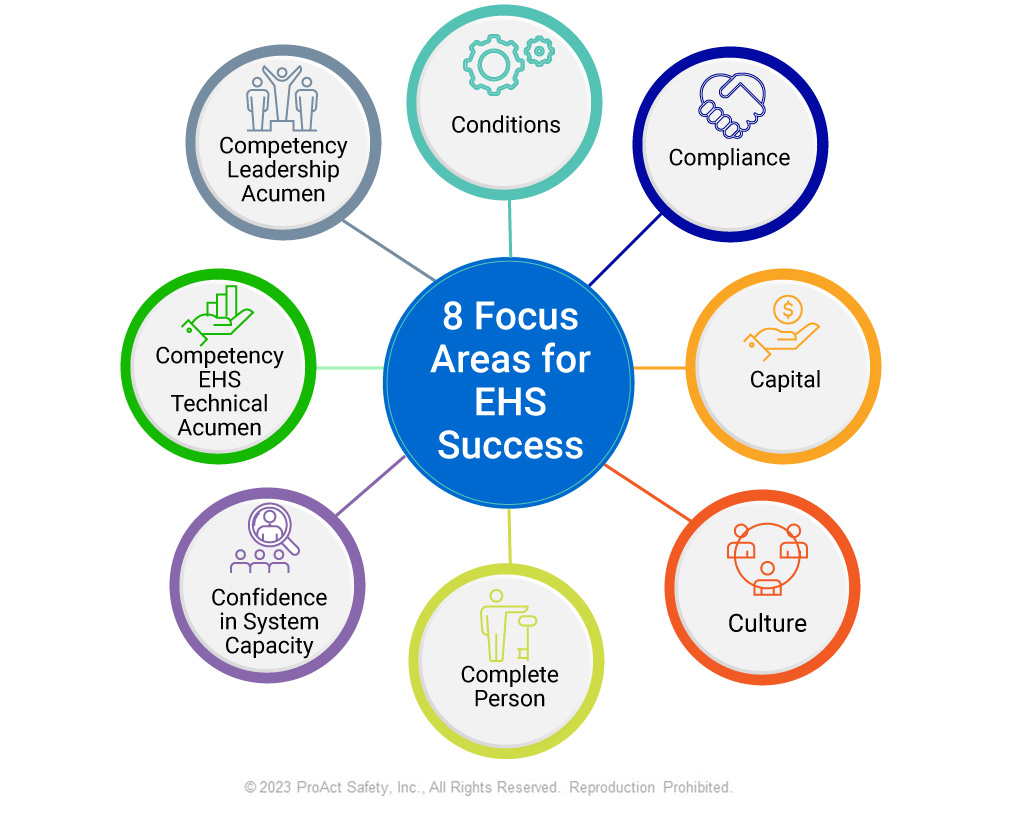BIC - March 2023
By: Shawn M. Galloway
Printable Version
Where environmental, health and safety (EHS) efforts are focused must create value for the organization. Additionally, what the EHS efforts concentrate on must create the perception of value for those within the organization. There must be an EHS strategy that delivers this. Being strategic is about creating and delivering value. How correctly focused is your strategy?
As an advisor and coach to organizations pursuing EHS excellence, I consider eight areas when helping them improve the efficacy of their strategy. As you read each of these areas and view the supporting figure, give your organization a score of one (nonexistent or not considered) through ten (sustainable excellence achieved).
Conditions — Workplace conditions are managed effectively through a continuous effort to identify and mitigate hazards and risks.
Compliance — Local, federal and company workplace EHS compliance requirements are regularly reviewed and adhered to.
Capital — The process for how money is allocated allows the organization to strategically and tactically invest in continuous improvement.
Culture — There is cultural capacity to support and reinforce the EHS systems. The desired beliefs, behaviors and experiences exist, and there is a shared mindset that continuous improvement will always be possible. EHS is viewed as the way business objectives are met.
Complete Person — The organization has systems to support the complete person, including mental health and psychological safety, and provides education on nutrition and healthy food options in company cafeterias or break rooms.
Confidence in System Capacity — There is confidence in the capacity of the EHS system (hierarchy of controls) to prevent incidents and injuries. However, because human error occurs in complex environments, the system has recovery mechanisms to reduce the severity of unwanted events and bring individual(s) or operations back to the pre-event state. There is confidence in the system's capacity to prevent deviations from expectations, and recovery systems to recover when deviations occur.
Competency EHS Technical Acumen — All personnel in the organization maintain the necessary EHS technical acumen to understand regulatory requirements and the EHS expectations of the organization. Everyone has the knowledge and competencies to perform their tasks in a way that supports the work as planned and know what to do to contribute to an incident-free outcome.
Competency Leadership Acumen — All leaders understand their role in supporting the EHS strategy. These individuals work continuously to create a motivational environment that yields discretionary effort with EHS activities. They know their people and how to get the best out of them.

Figure: 8 Focus Areas for EHS Success
Organizations will not achieve excellence in these eight areas quickly or sustainably without a multi-year strategy operationalized within leadership. This EHS strategy must support, rather than conflict with, the overall business strategy. How would you prioritize these eight focus areas based on the scores you have given them? How do other leaders rate them? Use this model to collaborate with your stakeholders to improve the effectiveness of your EHS strategy.

Shawn Galloway, CEO of ProAct Safety, is an expert in safety excellence. With almost thirty years of experience, he is a highly sought-after advisor, keynote speaker, and expert witness. Shawn has become a trusted partner to leading organizations across various industries worldwide. He ranks in the top 1% of the most prolific writers in his field, having authored over 500 articles and several bestselling books. He also launched the world's first safety podcast, Safety Culture Excellence©. As a recognized authority in safety, Shawn has received awards such as being named among the Top 50 People Who Most Influence EHS and a Top 10 Speaker, among others.
He is a regular guest on Bloomberg, Fox News, The Daily Mail, Dubai One, U.S. News & World Report, Sirius Business Radio, Wharton Business Daily, and leading safety magazines and podcasts. Shawn also serves as a member of the Harvard Business Review Advisory Council, Forbes Business Council, and Fast Company Executive Board, enabling his influence to shape safety thinking and strategy at the executive level.
